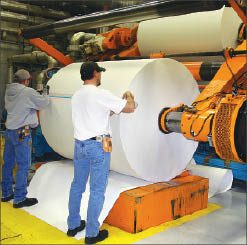
Home » Say hello to Clearwater
Say hello to Clearwater
Newest publicly traded company here has expansive operations

On Dec. 16, Spokane quietly became home to a new billion-dollar company, as Spokane-based Potlatch Corp. completed a spin-off of its expansive pulp and paperboard operations.
Although the new enterprise, Clearwater Paper Corp., employs just 25 people at its new headquarters offices in the Bank of America Financial Center downtown, it gives Spokane the bragging rights of having another publicly traded company based here. And it's no ma-and-pa venture. Clearwater Paper employs 2,460 people and has annual sales of about $1.26 billion. Meanwhile, Potlatch, which now employs 970 people and has sales of about $440 million, also remains based here.
Oh, and for the cocktail party circuit, here's another bragging right: Clearwater Paper makes more than 90 percent of the private-label toilet paper sold in grocery stores in the western U.S., and 56 percent of such tissue sold nationally.
That's no laughing matter for the managers at Clearwater's sprawling operations in Lewiston, Idaho, where the company makes much of that tissue, along with a host of other products—from napkins and paper towels to the coated paperboard used in everything from milk cartons to packaging for cosmetics and software.
There, Rick House, finished products manager for pulp and paperboard, has watched what he describes as a complete turnaround occur at the 880-acre complex over the past decade. That complex includes a pulp mill, a tissue operation, a paperboard operation, and a lumber mill. In all, it employs more than 1,600 people.
The turnaround, says House, was sparked by a realization by both workers and managers that if the operation was going to survive amid stiff competition, it would need to produce higher-quality products and with greater efficiency.
The improvements included capital investments by Potlatch, but also creative thinking by workers, engineers, and managers there, he says. Workers learned that the equipment could do far more than they thought possible, and that they could up their own games, too, House says.
In some cases, engineers designed upgrades that used scrap parts and enabled the mills to make million-dollar upgrades for a couple of hundred thousand dollars. Performance charts posted in the mills now create competition between shifts to achieve greater efficiency and quality.
"We have had improvements across the board," House says. "I can't tell you how proud I am of these people."
Such gains, says the company's first president and CEO, Gordon L. Jones, will determine Clearwater Paper's future, especially in terms of whether it will be able to expand its reach nationally.
"It's all about how we perform," says Jones.
Clearwater Paper expects to post its first full quarter of earnings as an independent company next week. Its 10-K annual report for 2008, released last month, includes sales and profit numbers presented as if it were a stand-alone company, though it was part of Potlatch for all but two weeks of 2008. The figures showed net income of $9.7 million for the year, compared with $25.3 million in 2007. Sharply lower fourth-quarter earnings were hurt by increased costs for wood fiber, energy, and chemicals.
Clearwater Paper operates in three business segments.
Its consumer products division makes a variety of tissue products, including napkins and paper towels, sold primarily under private-label brands at grocery stores. Fourth-quarter operating income in that segment more than tripled, to $15.7 million, compared with the year-earlier quarter, as sales jumped 9 percent, fueled mostly by higher market prices.
"Consumer products are going very, very well right now," says Jones.
The company operates four tissue-making machines—three in Lewiston and one at a facility in Las Vegas, Nev. It also operates what are called "conversion facilities," which slice the giant rolls of tissue produced on the big tissue machines into smaller rolls and sheets for end products. It has such facilities in Lewiston, Las Vegas, and Elwood, Ill., near Chicago.
Its pulp and paperboard division makes a host of bleached paperboard products, including stock used to make everything from paper cups and food cartons to high-gloss product packaging and point-of-sale placards. In addition to the pulp it uses in its own mills, it sells some in the open market, primarily to overseas customers. Fourth-quarter sales in that segment were up slightly from a year earlier, and paperboard prices were strong, but shipments of both pulp and paperboard fell and cost increases outpaced price improvement.
The company operates pulp and paperboard mills in Lewiston and in Cypress Bend, Ark.
Clearwater's paperboard plants are among a small tier of such plants nationally that are capable of producing the highest-quality paperboard available in the industry, it says.
"If we stay high quality we're in good shape," says Jones. "There just aren't that many of us. It's too capital intensive a business to get into. If you have a paperboard mill, you have a franchise."
The company's wood-products division consists of a single lumber mill at Lewiston. Though Potlatch retained all its other wood-products operations in the spin-off, Clearwater ended up with the Lewiston mill because it is integrated so closely into the pulp and mill operations there. The mill produces dimensional lumber and specialty cedar products, all of which are sold under the Potlatch name through a distribution agreement.
Like most wood-products operations these days, Clearwater Paper's mill posted an operating loss in the fourth quarter, caused by a continued softness in lumber demand nationally. Shipments were down 24 percent and prices were off 30 percent from a year earlier.
In the U.S. market, Clearwater Paper's products are sold mostly in the Western and Midwestern states, though it has been pushing farther into East Coast markets. For tissue products, which are bulky, transportation costs limit how far product can be shipped from a factory and still sell for a competitive price, which is why Clearwater uses conversion facilities to break down large rolls, which are dense and heavy, into smaller ones closer to markets it serves.
The company has talked about possible expansion farther east, but that, says Jones, is a capital-intensive endeavor that would depend on Clearwater's performance. "If we generate good returns," then Clearwater Paper can consider such expansions, he says.
He adds, "There's still some capacity at our plants. We plan to take advantage of incremental changes, make advancements that change productivity."
One of the challenges the company faces is a dwindling supply of the wood fiber used in making pulp. As lumber mills cut production in response to the housing slump, a smaller amount of wood chips and sawdust is available to sell to pulp makers such as Clearwater Paper.
Jones says that although the company hasn't had trouble getting the fiber it needs, it now often must buy it from farther away, increasing costs. Last year, fiber costs rose 25 percent. Meanwhile, energy costs jumped 32 percent and chemical costs increased by 20 percent, the company says. Some cost increases now have moderated, but Clearwater Paper still is trying to recoup the lost margin the increases have caused, Jones says.
The spin-off
Jones says the spin-off of Clearwater Paper was a natural next step for Potlatch, which became a real estate investment trust in 2006. As a REIT, Potlatch began putting greater focus on realizing value from its land holdings, which in addition to supplying logs to its wood-products operations also can be sold or developed to create revenue if not needed for logs. Spinning off the pulp, tissue, and paperboard operations, provided more clarity about Potlatch to investors, he says.
Before the spin-off, he says, "When you compete for investor dollars, you're a REIT, but not really a REIT. They treat you like a semi-REIT. Now, we're two independent companies. You have a pure-play pulp and paperboard company and a pure-play REIT."
Potlatch announced it was considering the spin-off last spring. By fall, however, the U.S. credit markets had imploded, throwing a wrench into Potlach's plans for funding the spin-off. Those plans called for Clearwater to raise a net of about $150 million from the sale of high-yield notes, and to use that money to pay Potlatch for Clearwater's share of Potlatch's debt. With suddenly little appetite in the market for high-yield debt investments, Potlatch had to find another funding source.
"It made it significantly more difficult," Jones recalls. "The Potlatch people got creative."
What they came up with was to have Clearwater increase an already negotiated line of credit to $120 million, from $75 million, then draw $50 million from that line to pay Potlatch. Clearwater also would take on the obligation to pay $100 million in existing Potlatch debentures.
What made it doable, says Jones, was that the new plan "wasn't pegged to finding a bunch of lenders in a totally closed market."
Under the spin-off, Potlatch shareholders received one share of Clearwater Paper for every 3 shares they owned in Potlatch. Clearwater's shares are traded on the New York Stock Exchange under the symbol CLW.
Potlatch retained six wood-products facilities and owns 1.7 million acres of forestland in Arkansas, Idaho, Minnesota, and Wisconsin. Its closest mills are in Post Falls and St. Maries, Idaho.
Jones says that when Potlatch spun off Clearwater, the new company could have chosen any city for its headquarters.
"We had other options, but there were distinct advantages of being here," he says.
Among those advantages was Washington state's lack of an income tax, which Jones says was a key factor in Clearwater's decision. Also, Spokane is located a two-hour drive from Lewiston, where the company's biggest complex is located. Spokane's quality of life and modest costs also were a factor.
The company leases about 9,000 square feet of space on the 11th floor of the Bank of America tower downtown.
Before being chosen to head Clearwater, Jones, 59, most recently had headed his own investment company, but prior to that spent about 30 years in the pulp and paper industry, including a stint as president and CEO of Canton, N.C.-based Blue Ridge Paper Products Inc.
Latest News
Related Articles




